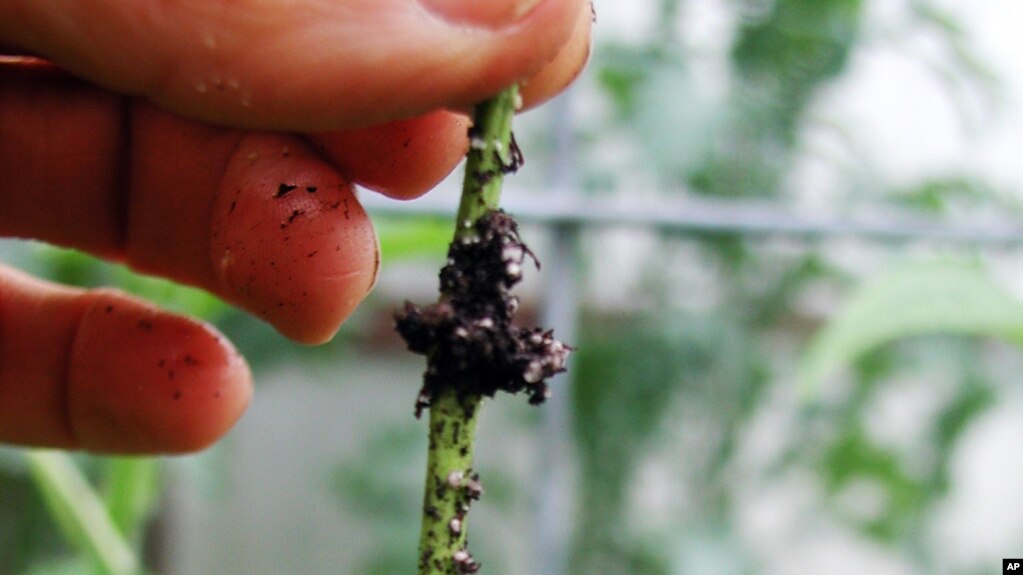
This July 1, 2013 photo shows a rooted softwood cutting in New Paltz, New York. Take a look at new shoots growing on a favorite shrub or vine and you'll see that the bases of these shoots may be beginning to toughen up, their once soft, green outer layer
People who are good at growing plants know that it is possible to plant what seems to be a lifeless stick and produce a tree or other kind of plant.
The stick is a really what is called a hardwood cutting. From these cuttings, trees, vines and shrubs can grow. They are called “hardwood” because the pieces are woody rather than leafy.
Not every woody plant will take root and start to grow from hardwood cuttings. Gardeners can expect close to 100 percent success with plants such as grape, currant, gooseberry, privet, spiraea and honeysuckle. However, this method does not work with apple, maple or oak trees, for example.
Because they lack leaves, hardwood cuttings are less perishable than “softwood cuttings.” They have leaves that can dry out rooting stems before roots can form.
If you want to develop a “green thumb” – or get really good at growing plants start your effort with hardwood cuttings of willow. Willow trees often spread from branches that take root on top of the ground through the winter. Most other plants demand a little more attention.
How to make cuttings
The autumn is a good time to start hardwood cuttings. Step back and look at the plant. Choose some shoots that grew during the most recent growing season the youngest shoots. Choose ones that are not too fat or too thin.
Cut the shoots to a length of about 15 centimeters. The cut at the top should be just above a node where a leaf was attached. The cut at the bottom should be just below a swollen node. Make sure you remember which end was up – the end that is farther from the root. Experts do this by cutting the bottoms off squarely and the tops at an angle so they avoid mistakes during planting.
Then, place the bottom of each cutting into some well-drained soil. It should be deep enough so that only the top node still shows. If you plant cuttings in autumn, cover the area with mulch to keep the soil warmer and to prevent the freezing and warming of the ground from harming the cuttings during the winter. If you plant the cuttings in a temporary planting bed, the rooted plants should be ready to move to their permanent homes by the next autumn.
Storing cuttings
It is possible to plant the cuttings in the ground in spring, too. Experts like fall planting more because the cuttings have a chance to take root before the tops start growing leaves in spring. New shoots cannot grow until after they have experienced winter cold.
Spring planted cuttings often begin new top growth before root growth begins. The shoots soon find there are no roots to sustain them. Then, they fail to survive.
If you have to plant in the spring, the cuttings need to be kept cool and wet through the winter. The traditional storage method is to place the cuttings together and bury them upside down in the soil. This lets the bottoms of the cuttings be first to feel the warming effects of spring sun on the ground. This method also prevents untimely shoot growth because they are buried deeper in cold ground.
A refrigerator also works. Put the cuttings in a closed plastic bag, put a wet paper towel around the bag, and then put the whole thing in another plastic bag. And, plant the cuttings as early as possible in spring, as soon as winter’s extra wetness has dried from the ground.
I'm Alice Bryant. And I'm Mario Ritter.
Lee Reich reported this story for the Associated Press. Mario Ritter Jr. adapted it for VOA Learning English. Ashley Thompson was the editor.
_______________________________________________________________
Words in This Story
vine –n. a plant with very long stems that grows along the ground or around something
shrub –n. a plant with stems and wood but is smaller than a tree
perishable –adj. likely to spoil or decay quickly
stem –n. a long thin part of a plant that rises above the ground and supports leaves or flowers
vigor –n. strength, energy or the ability to grow and move
node –n. a small round growth on a plant stem where a leaf grows
mulch –n. usually an organic plant material that is used to spread over the ground in a garden to prevent weeds and protect plant roots
drain – v. to remove liquid from something
refrigerator – n. a household device used to keep food cold
towel – n. a cloth used to dry things
We want to hear from you. Write to us in the Comments section, and visit our Facebook page.
Comprehension Quiz
When is a good time to start hardwood cuttings?